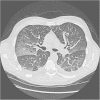Cardiopulmonary involvement in Puumala hantavirus infection
- PMID: 24160911
- PMCID: PMC4231367
- DOI: 10.1186/1471-2334-13-501
Cardiopulmonary involvement in Puumala hantavirus infection
Abstract
Background: Hantavirus infections cause potentially life-threatening disease in humans world-wide. Infections with American hantaviruses may lead to hantavirus pulmonary syndrome characterised by severe cardiopulmonary distress with high mortality. Pulmonary involvement in European Puumala hantavirus (PUUV) infection has been reported, whereas knowledge of potential cardiac manifestations is limited. We aimed to comprehensively investigate cardiopulmonary involvement in patients with PUUV-infection.
Methods: Twenty-seven hospitalised patients with PUUV-infection were examined with lung function tests, chest high-resolution CT (HRCT), echocardiography including speckle tracking strain rate analysis, ECG and measurements of cardiac biomarkers N-terminal pro-B-type natriuretic peptide (NT-ProBNP) and troponin T. Patients were re-evaluated after 3 months. Twenty-five age and sex-matched volunteers acted as controls for echocardiography data.
Results: Two-thirds of the patients experienced respiratory symptoms as dry cough or dyspnoea. Gas diffusing capacity was impaired in most patients, significantly improving at follow-up but still subnormal in 38%. HRCT showed thoracic effusions or pulmonary oedema in 46% of the patients. Compared to controls, the main echocardiographic findings in patients during the acute phase were significantly higher pulmonary vascular resistance, higher systolic pulmonary artery pressure, lower left ventricular ejection fraction and impaired left atrial myocardial motion. Pathological ECG, atrial fibrillation or T-wave changes, was demonstrated in 26% of patients. NT-ProBNP concentrations were markedly increased and were inversely associated with gas diffusing capacity but positively correlated to pulmonary vascular resistance. Furthermore, patients experiencing impaired general condition at follow-up had significantly lower gas diffusing capacity and higher pulmonary vascular resistance, compared to those feeling fully recovered.
Conclusions: In a majority of patients with PUUV-infection, both cardiac and pulmonary involvement was demonstrated with implications on patients' recovery. The results demonstrate vascular leakage in the lungs that most likely is responsible for impaired gas diffusing capacity and increased pulmonary vascular resistance with secondary pulmonary hypertension and right heart distress. Interestingly, NT-ProBNP was markedly elevated even in the absence of overt ventricular heart failure. The method of simultaneous investigations of important cardiac and respiratory measurements improves the interpretation of the underlying pathophysiologic mechanisms.
Figures

Similar articles
-
Cardiac troponin T and NT-proBNP as diagnostic and prognostic biomarkers of primary cardiac involvement and disease severity in systemic sclerosis: A prospective study.Eur J Intern Med. 2019 Feb;60:46-53. doi: 10.1016/j.ejim.2018.10.013. Epub 2018 Oct 23. Eur J Intern Med. 2019. PMID: 30366614
-
Plasma B-type natriuretic peptide (BNP) in acute Puumala hantavirus infection.Ann Med. 2014 Feb;46(1):38-43. doi: 10.3109/07853890.2013.862960. Epub 2014 Jan 6. Ann Med. 2014. PMID: 24393073
-
Hantavirus cardiopulmonary syndrome due to Puumala virus in Germany.J Clin Virol. 2016 Nov;84:42-47. doi: 10.1016/j.jcv.2016.10.004. Epub 2016 Oct 4. J Clin Virol. 2016. PMID: 27721108
-
Cardiac dysfunction in exacerbations of chronic obstructive pulmonary disease is often not detected by electrocardiogram and chest radiographs.Intern Med J. 2019 Jun;49(6):761-769. doi: 10.1111/imj.14144. Intern Med J. 2019. PMID: 30324703
-
Innate and adaptive immune responses against human Puumala virus infection: immunopathogenesis and suggestions for novel treatment strategies for severe hantavirus-associated syndromes.J Intern Med. 2019 May;285(5):510-523. doi: 10.1111/joim.12876. Epub 2019 Feb 17. J Intern Med. 2019. PMID: 30663801 Free PMC article. Review.
Cited by
-
Human Puumala hantavirus infection in northern Sweden; increased seroprevalence and association to risk and health factors.BMC Infect Dis. 2016 Oct 13;16(1):566. doi: 10.1186/s12879-016-1879-2. BMC Infect Dis. 2016. PMID: 27737653 Free PMC article.
-
Bilateral massive pneumonia as an unusual manifestation of Puumala hantavirus infection.J Postgrad Med. 2018 Oct-Dec;64(4):237-239. doi: 10.4103/jpgm.JPGM_283_17. J Postgrad Med. 2018. PMID: 30136660 Free PMC article.
-
The kidney in hantavirus infection-epidemiology, virology, pathophysiology, clinical presentation, diagnosis and management.Clin Kidney J. 2022 Jan 29;15(7):1231-1252. doi: 10.1093/ckj/sfac008. eCollection 2022 Jul. Clin Kidney J. 2022. PMID: 35756741 Free PMC article. Review.
-
Generation of plasma cells and CD27-IgD- B cells during hantavirus infection is associated with distinct pathological findings.Clin Transl Immunology. 2021 Jul 12;10(7):e1313. doi: 10.1002/cti2.1313. eCollection 2021. Clin Transl Immunology. 2021. PMID: 34277007 Free PMC article.
-
Human hantavirus infection elicits pronounced redistribution of mononuclear phagocytes in peripheral blood and airways.PLoS Pathog. 2017 Jun 22;13(6):e1006462. doi: 10.1371/journal.ppat.1006462. eCollection 2017 Jun. PLoS Pathog. 2017. PMID: 28640917 Free PMC article.
References
-
- Duchin JS, Koster FT, Peters CJ, Simpson GL, Tempest B, Zaki SR, Ksiazek TG, Rollin PE, Nichol S, Umland ET. et al.Hantavirus pulmonary syndrome: a clinical description of 17 patients with a newly recognized disease. The Hantavirus Study Group. N Engl J Med. 1994;330:949–955. doi: 10.1056/NEJM199404073301401. - DOI - PubMed
Publication types
MeSH terms
Substances
LinkOut - more resources
Full Text Sources
Other Literature Sources
Medical
Research Materials

